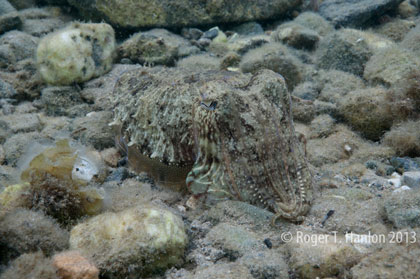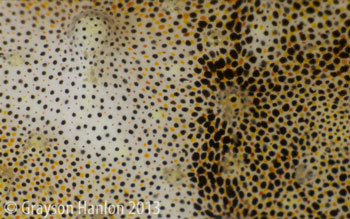Harvard-MBL Bioengineering Collaboration Uncovers New Reflective Mechanism in Cuttlefish Skin

CONTACTS: Caroline Perry, Harvard School of Engineering and Applied Sciences
(617) 496-1351, cperry@seas.harvard.edu
Diana Kenney, Marine Biological Laboratory
508-289-7139; dkenney@mbl.edu
High-resolution images are available upon request.
Cambridge, Mass., and Woods Hole, Mass.—Scientists at Harvard University and the Marine Biological Laboratory (MBL) hope new understanding of the natural nanoscale photonic device that enables a small marine animal to dynamically change its colors will inspire improved protective camouflage for soldiers on the battlefield.
The cuttlefish, known as the "chameleon of the sea," can rapidly alter both the color and pattern of its skin, helping it blend in with its surroundings and avoid predators. In a paper published January 29 in the Journal of the Royal Society Interface, the Harvard-MBL team reports new details on the sophisticated biomolecular nanophotonic system underlying the cuttlefish’s color-changing ways.
In addition to textiles for military camouflage, the findings could also have applications in materials for paints, cosmetics, and consumer electronics.
 A camouflaging cuttlefish (Sepia officinalis) on the ocean floor. Credit: Roger Hanlon
A camouflaging cuttlefish (Sepia officinalis) on the ocean floor. Credit: Roger Hanlon"Nature solved the riddle of adaptive camouflage a long time ago," said Kevin Kit Parker, Tarr Family Professor of Bioengineering and Applied Physics at the Harvard School of Engineering and Applied Sciences (SEAS) and core faculty member at the Wyss Institute for Biologically Inspired Engineering at Harvard. “Now the challenge is to reverse-engineer this system in a cost-efficient, synthetic system that is amenable to mass manufacturing."
Project collaborators Roger Hanlon and his colleagues at the MBL in Woods Hole, Mass., have been examining rapid adaptive camouflage in the cuttlefish and other cephalopods, including squid and octopus, for many years. "Cuttlefish skin is unique for its dynamic patterning and speed of change," Hanlon said.
The Harvard-MBL team uncovered an unexpected function in the pigment organs, or chromatophores, in cuttlefish skin.
"Chromatophores were previously considered to be pigmentary organs that acted simply as selective color filters,” said coauthor Leila F. Deravi, a research associate in bioengineering at Harvard SEAS. “But our results suggest that they play a more complex role; they contain luminescent protein nanostructures that enable the cuttlefish to make quick and elaborate changes in its skin pigmentation."
When the cuttlefish actuates its coloration system, each chromatophore expands; the surface area can change as much as 500 percent. The Harvard-MBL team showed that within the chromatophore, tethered pigment granules regulate light through absorbance, reflection, and fluorescence, in effect functioning as nanoscale photonic elements, even as the chromatophore changes in size.
 Cuttlefish skin; the chromatophores contain yellow, orange or black pigments. Credit: Grayson Hanlon
Cuttlefish skin; the chromatophores contain yellow, orange or black pigments. Credit: Grayson Hanlon“This was the real surprise. How on earth does the chromatophore maintain color fidelity when spread out in this thin layer, sometimes only 2-3 tiny pigment granules thick?” Hanlon said. “It turned out that the chromatophores also contain reflectin proteins, which were previously only known to be in iridescent cells. Nobody thought they would be found in chromatophores. The reflectin proteins may help to reflect light more efficiently from the pigment granules, but elucidating this remains the next challenge. Such a mechanism would interest many who study the optical qualities of pigments, not just in cuttlefish.”
"The cuttlefish uses an ingenious approach to materials composition and structure, one that we have never employed in our engineered displays,"said coauthor Evelyn Hu, Tarr-Coyne Professor of Applied Physics and of Electrical Engineering at SEAS. "It is extremely challenging for us to replicate the mechanisms that the cuttlefish uses. For example, we cannot yet engineer materials that have the elasticity to expand 500 times in surface area. And were we able to do so, the richness of color of the expanded and unexpanded material would be dramatically different—think of stretching and shrinking a balloon. The cuttlefish may have found a way to compensate for this change in richness of color by being an 'active' light emitter (fluorescent), not simply modulating light through passive reflection."
"Deciphering the relative roles of pigments and reflectors in soft, flexible skin is a key step to translating the principles of actuation to materials science and engineering,” Hanlon said. “This collaborative project expanded our breadth of inquiry and uncovered several useful surprises, such as the tether system that connects the individual pigment granules."
Other MBL scientists on the team included George R. R. Bell, Lydia M. Mäthger, Stephen L. Senft, Trevor J. Wardill, and Alan M. Kuzirian, all of whom work with Hanlon in the MBL’s Program in Sensory Physiology and Behavior.
This release was adapted from press information provided by the Harvard School of Engineering and Applied Sciences. For more information, please see the Harvard press release.
Citation:
Deravi LF, Magyar AP, Sheehy SP, Bell GRR, Mäthger LM, Senft SL, Wardill TJ, Lane WS, Kuzirian AM, Hanlon RT, Hu EL and Parker KK (2014). The structure–function relationships of a natural nanoscale photonic device in cuttlefish chromatophores. J. R. Soc.Interface 11: 20130942.
—###—
The Marine Biological Laboratory (MBL) is dedicated to scientific discovery and improving the human condition through research and education in biology, biomedicine, and environmental science. Founded in Woods Hole, Massachusetts, in 1888, the MBL is a private, nonprofit institution and an affiliate of the University of Chicago.